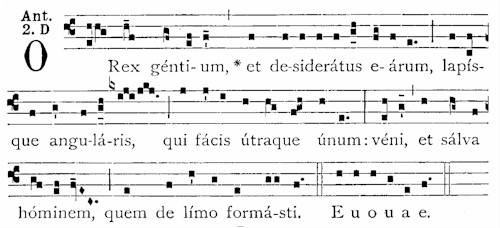 A continuation of our look at the O Antiphons for these last few days before Christmas…
A continuation of our look at the O Antiphons for these last few days before Christmas…
LATIN: O Rex gentium, et desideratus earum, lapisque angularis, qui facis utraque unum: veni, et salva hominem, quem de limo formasti.
ENGLISH: O King of the gentiles/nations and their desired One, the cornerstone that makes both one: come, and deliver man, whom you formed out of the mud.
Scripture Reference:
Revelation 15:3
Psalm 118:22
Isaiah 28:16
Matthew 21:42
Mark 12:10
Luke 20:17
Acts 4:11
Ephesians 2:20
I Peter 2:6
Relevant verse of Veni, Veni Emmanuel:
O come, Desire of nations, bind,
In one the hearts of all mankind;
Bid Thou our sad divisions cease,
And be Thyself our King of peace.
During Advent, the Voice of the Word, the greatest man born of woman, St. John the Baptist calls for us to prepare the way for the Lord who is coming. The Lord is coming by the straight path, whether we have straightened it or not.
The Baptist’s message has it its core his own mission statement: He must increase, I must decrease.
In life we experience many different forms of “straightening” and “decreasing”.
Chief among them is rejection, with the pain that comes with it.
The King who is coming sacramentally and liturgically at Bethlehem teaches us how to empty ourselves and how to endure the emptying which comes from the vicissitudes of our fallen state, our face to face and heart to heart meetings with cruelty, malice and indifference.
Allow me to riff on a word or two. Let’s take limus… mud.
In English when we “mud” something, we use a kind of cement. To “lime” something is to put a sticky covering on it. Ezekiel describes the walls that are limed with mud. The Jews in Egypt made bricks from mud and Nahum describes making bricks of mud to strengthen walls. The Lord used mud of saliva to heal a blind man. Of course we human beings were made by God from the mud, sometimes described as mud’s opposite, dust. Hebrew aw-fawr’ means, “clay, earth, mud:—ashes, dust, earth, ground, mortar, powder, rubbish.”
Limus is, ironically, something which falls apart like dust and which sticks things together like cement. Christ, when He comes as Liberator, will free everyone to do as he pleases. Some will be blown like dust in their self-liberation. Others will freely stick to Christ like cement, and in Him be truly free.
Christ is the connector.
He is the cornerstone in the antiphon, which is an allusion to the cornerstone that was rejected. In Acts 4 Peter, filled with the Holy Spirit, preached about the stone that builders rejected. Peter repeated what he heard Christ quote, Ps 118, one of the great Hallel psalms, about the stone rejected by the builders winding up being the corner stone. Ps 118 is one of the six Psalms which were recited at Pesach, Shavuot, Sukkot, on Shemini Atzeret and Simchat Torah, and on the eight days of Hanukkah. Peter uses the image again in 1 Peter 2. Everyone would have recognized the reference. But Peter goes on saying: “But you are a chosen race, a royal priesthood, a holy nation, God’s own people, that you may declare the wonderful deeds of him who called you out of darkness into his marvelous light.”
In Ephesians 2:20 Paul has Christ as akrogoniaios – keystone, cornerstone. A cornerstone describes also a keystone, the sort of stone that caps an arch and, by its presence, holds the other stones in their proper places. A corner stone connects and holds together two walls. Christ holds together Jews and Gentiles, that is “everyone”. Holy Church, built on a Rock, is like a temple of living stones, limed and anointed with Christ, our mud mudded by and mortared to Christ. Those who are mud limus are cemented down in Him and we are truly free to be who we are. Those who chose the dust limus are blown away, atomized on the wind, never to with anything or anyone.
In calling Christ the King of the nations, gentiles, we have a reference to the Passion and to the Second Coming. As old Simon saw the Light of the Gentiles in the Infant Christ, we shall see the Light of the Son in glory in the Second Coming. Also, remember that when Christ was wroth that people had taken over a section of the Temple for commerce, etc., His anger stemmed from the fact that they had taken the Courtyard of the Gentiles. But the coming of the gentiles to find the Messiah was one of the signs that Christ’s mission was ready for its fulfillment in the Passion. When the Jews and gentiles joined in this way, “the day” was at hand when He would set us free from our sins.
Shall we hear the monks of Le Barroux? This was recordedin 2018, when 22 Dec fell on a Sunday. Hence, because they are incensing the altar during the Magnificat, etc., which takes a while they repeat the antiphon. Not a problem, of course!



































I just want to acknowledge my enjoyment of your series on the O Antiphons. The exhaustive scripture references that you’ve provided have helped me understand this bit of Christian patrimony, especially.
I wonder if Christ’s dual nature as True God and true man through the Hypostatic Union could also make up a part of the keystone, cornerstone references that are made about Christ? As True God, the term capstone could refer to Christ’s vertical divine nature as Son of the Father. As true man the term cornerstone could refer to Christ’s horizontal human nature that He took on during the Incarnation.